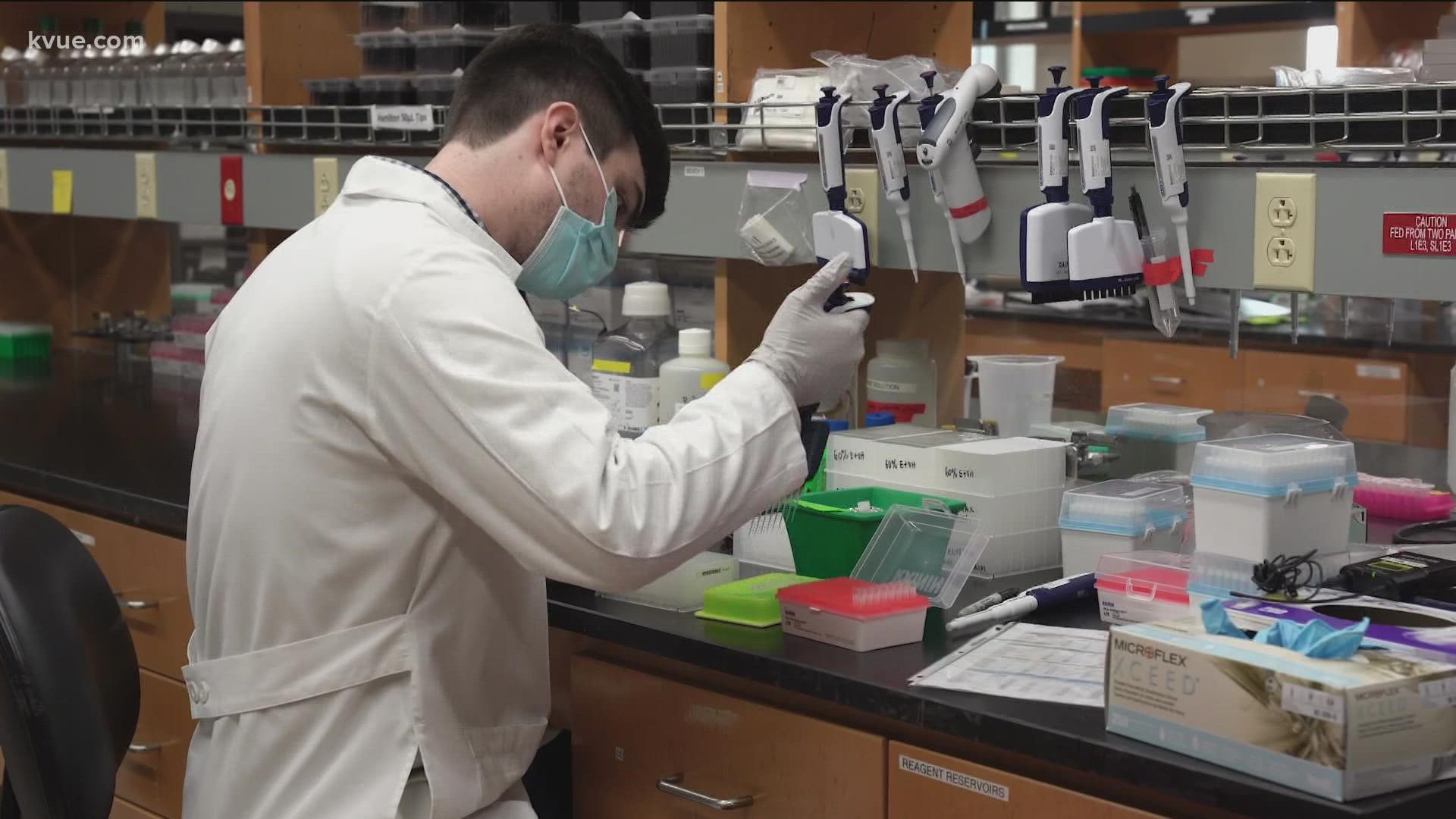AUSTIN, Texas — When we take a PCR (polymerase chain reaction) COVID-19 test, usually up the nose or spitting in a tube, the test ends up in a laboratory refrigerator. Any virus is killed immediately after the test was taken.
It takes scientists several steps to learn the result.
The machines at University of Texas at Austin use about a small portion of the specimen to test, leaving the rest in the refrigerator for a few days in case more samples are needed.
Each test contains a barcode that travels with it while getting processed. If a test return is positive, what happens next may change the way scientists and the public see the virus altogether.
“All life on Earth has to have a program that encodes its genetic information in the genome. For many organisms, that genome is DNA. Some can transmit their genetic information through a similar molecule called RNA,” Ilya J. Finkelstein, Ph.D., associate professor of molecular biosciences at University of Texas at Austin, said.
Researchers look for the genetic information through a process called genomic sequencing. Sequencing is the first step in hunting mutations and any known variants.
“The way you can see the virus on a molecular level is to read the letters that make up that virus,” Finkelstein said.
Finkelstein said SARS-CoV-2 is made up of a strand of RNA, similar to how we use DNA. The virus’s strand is made up of four molecules, adenine (A), cytosine (C), guanine (G) and uracil (U).
Those molecules get represented by its chemical base in a sequence, shown as either A, C, G or U. The same way 26 letters of the alphabet come together to form words, Finkelstein said those four letters combine in certain ways. Each combination is a set of instructions for the RNA cell to function.
The chemical makeup of the spike protein on SARS-CoV-2 shows if the virus could enter our cells or get blocked.
The SARS-CoV-2 spike is not a perfect fit, but the virus can make copies of itself if it gets inside our cells. It’s how the virus spreads.
“This is also the target of all of our antibodies. It’s the main constituent of all of our vaccines, this protein called spike,” Finkelstein said.
Reading and analyzing a full genomic sequence can take a week. The original genetic code for SARS-CoV-2 is nearly 30,000 letters long.
A virus genomic sequence constantly changes. When that change happens, scientists consider it a mutation. A variant is any virus that changes its sequence by at least one mutation.
The most common type of mutation is by substitution or deletion of a chemical. A virus may insert a “G” where a “U” should be, similar to how we make typos, he said.
It normally poses no threat, Finkelstein said.
Omicron is the first variant of concern to have a single insertion, which scientists are studying.
When changes happen to the spike protein, the virus may be able to enter our cells easier, evade our immune system and vaccines. The virus itself may be weaker or stronger, but it can spread faster.
“There are other mutations outside the genome of that spike. There are more mutations out there. Their functional significance is not clear. Many of them can be not important,” Finkelstein said.
Scientists all over Texas, the U.S. and the world share information about mutations they see. With the information, scientists built “family trees” that show how the mutations flow in a lineage.
SARS-CoV-2’s original strain mutated, the letters changed. As it spread, the strain kept changing. Some family lineages got stronger. Most died out, Finkelstein said.
Eventually with enough mutations, Finkelstein said, the stronger lineages emerged, leading to variants of concern like the alpha variant, delta variant and omicron.
“The goal of genetic surveillance is to read the letters of the genetic information from SARS-CoV-2, understand which kind of variants are being spread and use that to inform both treatment and public policy decisions,” Finkelstein said.
Genomic sequencing is how we find virus threats. That means we have to look.
“The U.S. is currently 4.5-5% sequencing of all of its cases,” Finkelstein said.
Texas records show the CDC sequenced 6% of the state’s positive cases in the past month.
“Many experts believe 5-10% sequencing is quite sufficient. It’s financially and logistically very difficult to sequence every single patient,” Finkelstein said.
State, private labs and universities like UT also run sequences.
“The main benefit here is surveillance. Do you really need to check every single patient?” said Finkelstein.
Some hospitals will run the genomic sequence for SARS-CoV-2 positive cases. Baylor, Scott & White, for example, sequenced more than 80% of its positive cases.
“How sensitive do you want to be in your surveillance? Do you want to find a really really rare thing, or do you want to find something that’s at the edge of being spreading globally? It’s a question of how much surveillance do you want,” Finkelstein said.
Antigen tests do not work for genomic sequencing.
Omicron is one of 27 variants named in the world on Dec. 13. The only way to stop more mutations and more variants is to stop the virus globally.
PEOPLE ARE ALSO READING:

